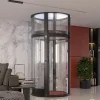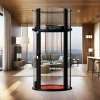When it comes to finding the best companies for elevator and escalator installation in the UAE, Lift Mart stands out as one of the top choices. With extensive experience in the field, Lift Mart offers a range of services that make them a trusted name. They have a skilled team of engineers and technicians who are fully capable of handling the installation and maintenance of all types of elevators and escalators.
Why Install Elevators & Escalators in the UAE?
Installing elevators and escalators in multi-story buildings in the UAE is essential. These systems save time and effort for anyone needing to move between floors. Elevators are especially beneficial for the elderly or people with disabilities, making it easier for them to move without stress. If you’re planning a commercial space or a service-oriented establishment, installing these systems will enhance comfort and luxury for visitors and customers.
Certainly, when looking to install an elevator or escalator, you’re seeking the best installation company in the UAE. Stay with us, and we’ll explain why Lift Mart is a standout choice.
Best home elevator company in sharjah
Lift Mart is one of the leading companies specialized in elevators and escalators in the United Arab Emirates. Here are the most important reasons why you should choose the best home elevator company in sharjah:
- Years of experience: The company has extensive experience in the field of designing, manufacturing, installing and maintaining elevators, ensuring that you receive high-quality service.
- Specialized team: The company’s team includes a group of highly trained engineers and technicians, capable of dealing with all types of elevators and providing innovative solutions.
- High-quality components: The company uses the best materials and components in the manufacture of its elevators, ensuring durability and high performance in the long term.
- Commitment to international quality standards: The company is keen to adhere to all international quality standards, ensuring that you receive a safe and reliable product.
- Integrated technical support: The company provides integrated technical support around the clock, to meet all your inquiries and needs.
- Periodic maintenance: The company provides periodic maintenance services for elevators to ensure that they operate efficiently and safely.
What’s the Difference Between Elevators and Escalators?
Both elevators and escalators are designed to move people between floors in buildings, but they work differently. Let’s break down the differences:
Elevators
Elevators are enclosed cabins powered by electric or hydraulic motors. They transport individuals or goods up and down between floors. Different types of elevators are available based on their purpose:
- Home elevators: These are compact, and suitable for villas or multi-story homes.
- Hospital elevators: Designed with larger cabins to transport patients on beds between floors.
- Freight elevators: Built for heavy-duty use, capable of transporting large or heavy items.
Escalators
Escalators are essentially moving staircases. They consist of steps fixed on an inclined belt that moves continuously, taking people from the bottom to the top or vice versa. The steps fold at the top and bottom to create a smooth transition onto the floor. This movement is repetitive, providing a continuous cycle of transportation.
But why install elevators or escalators in your building? Let’s take a look at the advantages.
Advantages of Installing Elevators & Escalators in Buildings
Elevators and escalators offer numerous benefits, making them a critical component in modern buildings. Here’s why:
Comfort and Ease of Movement
- Saving Physical Effort: Elevators and escalators are particularly useful for the elderly, children, and people with disabilities. They allow smooth, effortless movement between floors without physical strain.
- Ease of Transporting Goods: With elevators, transporting furniture, appliances, and heavy items between floors becomes easier, saving time and effort.
- Quick Access to All Floors: Elevators and escalators reduce the time it takes to move between floors, making them highly efficient, particularly in commercial and office spaces where time is money.
Safety and Security
- Risk Reduction: Elevators and escalators help reduce the risk of falls, especially on staircases, ensuring safety for users.
- Child Safety: With elevators, children can be monitored easily, ensuring a safer environment.
- Meeting Safety Standards: The installation of elevators and escalators is conducted with strict safety guidelines, ensuring reliable and safe operation.
Increase Property Value
- Attracting Tenants: Having elevators or escalators makes a building more attractive to tenants, whether individuals or businesses.
- Increased Sale Value: Properties with elevators and escalators installed often sell for higher prices, as these systems are seen as valuable amenities.
Improved Efficiency
- Boosting Productivity: In commercial spaces, elevators and escalators increase productivity by making it easier for employees and customers to move between floors.
- Saving Time and Effort: These systems reduce the time and energy required to travel between floors, thereby increasing efficiency.
Environmental Sustainability
- Energy Efficiency: Modern elevators and escalators are designed to operate more efficiently, using less energy.
- Reducing Emissions: These systems help reduce carbon emissions, making them more environmentally friendly.
In summary, installing elevators and escalators brings numerous benefits, making them indispensable in modern buildings across the UAE. They improve comfort, safety, efficiency, property value, and contribute to environmental sustainability.
Elevator Installation Process in the UAE
The elevator installation process in the UAE is a multi-step engineering task that requires careful planning and expert execution. Lift Mart’s team of professionals outlines the stages involved in the elevator installation procedure:
1. Obtaining Licenses
- Building Permit: The necessary permits are obtained from the local authorities to begin the installation process.
- Engineering Approvals: The design must be approved by the building’s consulting engineer to ensure it meets all safety standards.
2. Planning and Design
- Building Study: A thorough survey of the building is carried out to determine the optimal location for the elevator, evaluate the structure’s ability to support the elevator, and calculate the expected load.
- Choosing the Type of Elevator: The right elevator is selected based on factors such as the number of floors, load capacity, available space, and budget.
- Detailed Design: A detailed blueprint of the elevator is created, covering all technical specifications and dimensions. This is then integrated with the building’s general design.
3. Construction Works
- Well Preparation: The elevator well is prepared, including any required drilling and finishing works.
- Structure Installation: The metal framework of the elevator, including tracks, supports, and doors, is installed.
- Electrical and Mechanical Equipment Installation: Key components like motors, control panels, and safety systems are installed.
4. Installation and Testing
- Cabin Installation: The elevator cabin is installed and fitted with necessary lighting and ventilation.
- Final Tests: A series of load, performance, and safety tests are conducted to ensure the elevator operates smoothly and safely.
5. Operation and Maintenance
- Training: Staff are trained to operate and maintain the elevator properly.
- Periodic Maintenance: Scheduled maintenance is performed to ensure the elevator continues to function at its best.
Escalator Installation Procedure
The escalator installation procedure is similar in complexity to elevator installation. It follows a systematic approach to ensure safety, functionality, and durability. Here’s the step-by-step process for escalator installation:
1. Site Survey and Planning
A detailed survey of the building is conducted to determine the best location for the escalator. This includes studying the foot traffic flow and identifying suitable spaces for installation.
2. Design and Customization
The escalator is designed to match the building’s specifications, including length, angle of inclination, and expected user capacity.
3. Structural Preparation
The installation site is prepared, including floor reinforcements and necessary structural modifications to accommodate the escalator system.
4. Installation of Mechanical Components
The escalator’s trusses, motors, chains, and steps are installed. This step ensures that the escalator’s mechanical system functions smoothly.
5. Electrical Systems Installation
The control systems, lighting, and wiring are connected to the building’s power supply. Emergency systems, such as stop buttons and alarms, are also installed.
6. Testing and Calibration
The escalator undergoes rigorous testing to ensure smooth operation. Load tests are performed to check capacity, and safety systems are thoroughly tested.
7. Final Commissioning
Once the escalator passes all tests, it is commissioned for use. Regular maintenance schedules are established to keep the system running efficiently.
Conclusion
By partnering with experts like Lift Mart, you ensure that your elevator and escalator installation is handled professionally, delivering high-quality results that will enhance your building’s functionality, safety, and value.








